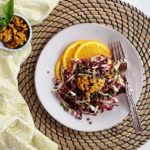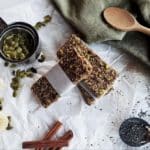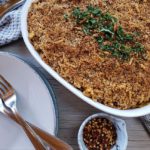Pantry Essentials
Now more than ever you want your pantry stocked properly with good, wholesome and nutrient-rich foods. Let’s be clear though – that doesn’t mean you need to go out and start hoarding everything and anything from every grocery store.
There is plenty of food to go around for everyone and in fact. We discourage panic-buying. It means less food for others who come shopping after you. Not to mention – it can be very expensive.
Most pantry staples are basic, versatile and easy to work with. Here are a few of our favourites and recipes to help you make good use of them!
Lentils
Lentils are a member of the pulse family, which are and come in an assortment of different types. The most common are, green, brown and red, with green and brown holding their shape more and are often used mashed into a vegetarian loaf or burger and can be even eaten as a side dish, or an ingredient in salads and soups to accompany any meal. Red lentils, on the other hand, are a lot mushier in consistency when cooked and often added to thicken soups, stews and used in purees. The shelf life of lentils if sealed and in an airtight container is up to 1 year. Ideally, they should be washed or rinsed prior to cooking and for those who suffer from gastrointestinal issues from consuming legumes, soaking them prior to use is ideal as this helps aid in their digestibility. They are a nutritional powerhouse food, with 22-24g of protein per ½ cup serving, which makes it an ideal food for vegans and vegetarians to have on hand, and are also rich in fibre, calcium and iron.
Lentil Radicchio Walnut Salad
Ingredients
Lentils:
- 1 cup Inari French Lentils cooked
- pinch Lumiere de Sel Fine Himalyan Salt to taste
Salad:
- 2 Frontier Bay Leaves
- 5 tbsp Nature’s Emporium Maple Syrup
- ½ tsp Frontier Chili Flakes
- ½ tsp Lumiere de Sel Fine Himalyan Salt
- ½ tbsp Nature’s Emporium Olive Oil
- 1 tsp water
- 1 cup Elan Walnuts
- 1 head organic ridichio thinly sliced
- ¼ cup organic basil chopped
- ½ cup organic parsley chopped
Dressing:
- ¼ cup Sarafino Red Wine Vinegar
- 6 tbsp Nature’s Emporium Olive Oil
- 2 tbsp Nature’s Emporium Fresh Orange Juice
- ½ tsp Lumiere de Sel Fine Himalyan Salt
- ¼ tsp Frontier Black Pepper
Instructions
- Preheat the oven to 350°F (177°C). As the oven preheats, line a sheet pan with parchment paper.
- Add the lentils to a pot of water with a large pinch of salt and the bay leaves. Bring the water to a boil and simmer until tender (approximately 20 minutes). Drain and set aside.
- In a small bowl, mix ½ of the maple syrup, chili flakes, turmeric, salt, olive oil and enough water to make a paste.
- Toss the walnuts in the paste and bake for 7-10 minutes (until golden). Then set them aside, let cool and then chop.
For the dressing:
- whisk the remaining maple syrup, red wine vinegar, extra virgin olive oil, orange juice, salt and black pepper.
- In a large bowl, add the lentils, radicchio, chopped walnuts and herbs. Pour in the dressing and toss to combine
Oats
Oats are such a versatile ingredient to have in your pantry, and come in a few different forms as well – steel cut, rolled, quick and scottish. However, even if you simply stock your pantry with regular rolled oats, and have a good food processor or blender, you will be able to transform them into different ingredients for recipes, like quick oats or oat flour so there’s no need to buy these separately and unnecessarily increase your grocery bill. In an airtight container and stored properly, oats can have a long shelf life of up to 18-24 months so this is something you can buy a large bag of and not worry about it spoiling anytime soon. Oats most common usage is for good old-fashioned oatmeal, but don’t let their usual form stifle your kitchen creativity. These can be used to make your own homemade granola and granola bars, power balls, desserts like pies and crumbles, muffins and cookies and not to mention can often be an ingredient in savoury meals as a binder in burgers and meatloaves, or even made into their own savoury side dish or main of a meal. Not to mention they add a nutritional boost to your smoothies and if you really want to get adventurous, you can even make your own oat milk which is a hugely popular item right now. Besides all the ways you can use oats, they also have great nutritionals, including a high amount and assortment of B-vitamins, magnesium and phosphorus, and not to mention a decent amount of of protein, at 6g per half cup and not to mention fibre rich to help with your digestive and cardiovascular health!
Protein Force Oat Bars
Ingredients
- 2 tbsp Nature’s Emporium Chia Seeds
- 6 tbsp water
- 1 ½ cups Nature’s Emporium Rolled Oats
- 1 cup Organic Traditions Unsweetened Shredded Coconut
- 2 tbsp Vega French Vanilla Protein Powder or your favourite protein poweder
- 2 tsp Nature’s Emporium Cinnamon
- ½ tsp Lumiere de Sel Fine Himalyan Salt
- ¾ cup Nature’s Emporium Pumpkin Seeds
- 1 cup Nature’s Emporium Dates pitted and chopped
- 3 organic medium-ripe bananas
- ½ tbsp Simply Organic Vanilla Extract
- ¼ cup Nature’s Emporium Maple Syrup
- ¼ cup Nature’s Emporium Coconut Oil melted
Instructions
- Line a 9×13” sheet pan with parchment paper and preheat oven to 350°F degrees. Mix the chia seeds and water together and set aside.
- In a large mixing bowl combine the oats, coconut flakes, protein, cinnamon, salt, pumpkin seeds and chopped dates and stir. Toss with your hands to coat the dates so it's easier to prevent clumping.
- In a food processor add the bananas, vanilla, maple syrup and oil and process until smooth.
- Add in the chia gel and pulse a few more times to combine.
- Pour the wet mixture into the bowl with the dry ingredients and stir to make sure everything is evenly coated.
- Spread on the prepared baking sheet, use an off set dipped in warm water to help smooth out the top evenly.
- Bake for 15 minutes, rotate, then bake another 15 minutes until golden.
- Let cool for 10 minutes then flip out onto a board to cut. They keep in the fridge for 4 days or can be frozen (preferably divided with parchment paper) for 1 month.
Notes
Quinoa
While mistakenly thought of as a grain, it’s actually what is called a “pseudograin”, meaning though they often are consumed similar to grains, they are not grains at all, and in fact seeds of grasses. When stored properly in the pantry (in an airtight container), quinoa can last up to 2 years, making it a great staple to keep your pantry stocked with. There are different colours of quinoa including white, red and black, with white being the most popular and widely available. They have slightly different cooking times and nutritional composition but nothing notable. Quinoa generally cooks up quickly in about 10-15 minutes, which makes it an easy food to prep and can be used in a multitude of ways. Quinoa is not just a side dish or salad, it can be used to make patties, a replacement for taco filling or oatmeal, in casseroles, desserts and so much more! Also of importance to mention is the super nutritional properties of quinoa, including the fact that it is one of the only vegetarian sources of protein that is considered complete, meaning it has all 9 essential amino acids, making it a great food for vegetarians and vegans to eat on a regular basis. Quinoa is also rich in many minerals like iron, magnesium and zinc and is also gluten-free, making it a great option for those who have gluten intolerance or celiac disease.
Quinoa Veggie Patties
Ingredients
- 1 ½ cup Organic Sweet Potatoes
- 1 ½ tbsp Nature’s Emporium Olive Oil for roasting, until fully coated
- sea salt to taste
- black pepper to taste
- 2 cups organic cremini mushromms
- ½ cup organic onion
- 1 ½ cups organic broccoli
- ½ cup organic red pepper
- 4 Nature’s Emporium Eggs
- 2 cups Nature’s Emporium Quinoa cooked according to package directions
- ¼ cup Bob’s Red Mill Oat Flour
- ½ cup Paneriso Gluten Free Bread Crumbs
- 1 tbsp Frontier Dried Basil
- 1 tbsp Frontier Dried Parsley
- 1 tsp Herbamare
- ¼ cup Bragg’s Nutritional Yeast
- ¼ – ½ tsp Frontier Garlic Powder to preference
Dipping sauce
- 3 tbsp Sunflower Kitchens Basil Pesto
- 1 cup Chosen Foods Avocado Mayonnaise vegan or regular
- 1 tsp fresh lemon juice
Instructions
- Preheat the oven to 350˚F (180˚C). Grease a baking sheet with nonstick spray.
- Cut sweet potatoes into small cubes (ideally ½ cm x ½ cm), coat with olive oil, sea salt and pepper. Bake for 20-25 minutes, or until tender.
- Cut onions, broccoli, mushrooms and red peppers into bite size pieces (ideally ½ cm x ½ cm). Set aside in separate bowls.
- Squeeze a clove of garlic through garlic press in a hot oiled pan.
- Saute mushrooms. When golden, add onions and saute.
- When onions become slightly translucent, add broccoli and cook for another 2 minutes or until broccoli is tender.
- When broccoli is tender add remaining red peppers and sprinkle some salt and continue to cook for another 2 minutes. Set aside.
- In a large bowl, beat the eggs. Then, add the quinoa, bread crumbs, oat flour, vegetable mixture, basil, parsley, salt, nutritional yeast and garlic powder. Mix well.
- Shape the quinoa mixture into 20 small patties. Place on the prepared baking sheet.
- Turn up oven to 375˚F (190˚C) and bake for 20 minutes, or until the patties are golden brown and crispy.
- In a separate bowl, add mayo and pesto, mix well. Adjust mayo or pesto to your liking. Place in a small dipping bowl and serve with the quinoa bites.
Notes
Squash
When you’re talking about pantry staples, squash isn’t often the first item that comes to mind, however it should be stored in a cool dark place and the pantry is the perfect place for it! While it doesn’t have the same shelf life as some of the other foods discussed previously in this post, it can last a little while in the pantry, up to 3 months depending on the quality when you purchased it. There are a ton of forms of winter squash, but the most common and commercially available are: spaghetti, butternut, acorn and pumpkin. These can all be used in many ways in main dishes, as well as sides. Spaghetti squash for example, when cooked up and shredded can be used as the noodles for spaghetti and meatballs, but can also be used as a main ingredient in fritters and even act as a healthier hash brown alternative. Butternut, acorn and pumpkin on the other hand, often make wonderful soups, spreads, purees, and can be a main ingredient in casseroles, desserts and more! While the nutritional properties of each of these types will slightly differ, they all typically contain a high amount of Vitamin A and C, fibre, magnesium and potassium.
Butternut Squash Mac & Cheese
Ingredients
- 1 butternut squash peeled, seeded and chopped
- 2 tbsp Nature’s Emporium Coconut Oil melted
- 1 tbsp Nature’s Emporium Olive Oil
- ½ organic medium Spanish onion chopped and sauteed
- 1 bag Tinkyada Rice Pasta Elbow Macaroni
- ½ cup organic potato peeled, chopped and boiled
- 1 cup Nature’s Emporium Vegetable Broth
- ½ cup water
- 2 tbsp Bragg’s Nutritional Yeast or more, to taste
- 1 tbsp fresh lemon juice
- ½ tsp Maison Orphee Dijon mustard
- ¼ tsp Frontier Garlic Powder
- ¼ tsp Frontier Paprika
- ¼ tsp Frontier Turmeric Powder
- ⅛ tsp Frontier Black Pepper
- 1 pinch Himalayan Sea Salt
Breadcrumb topping
- 1 cup Paneriso Gluten Free Bread Crumbs
- 2 tbsp Earth Balance Buttery Spread softened
- ½ cup Daiya Cheddar Cheese
Instructions
- Preheat oven to 400°F. Add chopped squash to a bowl with melted coconut oil, salt and pepper, mix well and evenly coat. Spread out on a baking sheet and roast for about 40 minutes, uncovered, until fork tender.
- On the stove top, add oil to a heated frying pan, and saute onions.
- Add water and chopped potatoes to a pot, bring to a boil and simmer for 20 min or until fork tender.
- In a vitamix or high-powered blender, add only 1 ½ cups of butternut squash (save extra squash for wraps or salads), onions, potatoes, vegetable broth, lemon juice, nutritional yeast, dijon mustard, garlic, black pepper, paprika, turmeric powder and sea salt. Blend on high and add water until desired consistency.
- Cook your pasta according to package directions. The sauce makes enough to cover 4-6 servings of pasta.
- Add sauce to the cooked macaroni in the pot and mix well.
- Pour macaroni and “cheese sauce” into a 7” x 11” baking dish.
- In a separate bowl, mix together bread crumbs, buttery spread and daiya cheese.
- Sprinkle evenly over pasta and bake.
- Turn oven down to 375°F and bake it for 12 minutes and then broil for the last minute until golden brown.
Oils
You don’t have to have every oil on the grocery shelf in your pantry, but having a few particular ones on hand will make cooking and baking anything a breeze! Don’t be fooled by claims of certain vegetable oils saying they are healthy options because many are pro-inflammatory and are already rancid prior to even opening them due to the way they are processed. The three I always have on hand are olive oil, coconut and avocado for varying reasons and each of these has a different smoke point, which is important for cooking methods. A smoke point of a particular oil determines the temperature of which the oil can reach before it reaches rancidity and is no longer healthy to consume. For example, olive oil has a lower smoke point compared to other oils and therefore should not be used for any higher heat cooking such as frying, and higher heat sauteing. It’s best used in salad dressings and drizzled over already cooked vegetables, grains and meats. Olive oil is also considered one of the healthiest oils due to the high amount of monounsaturated fats and antioxidants found in it. Coconut oil is another favourite to have on hand for baking as it can tolerate the higher heat of the oven and also lends flavour to the recipe when baking sweet items. Not to mention all the health benefits and uses of coconut oil which any quick google search will show you. Avocado oil is the last important one to keep in your pantry, as it can tolerate the highest heat during cooking, such as frying and generally has a very mild taste, making it super versatile for cooking or baking. Also important to note when selecting your oils, it’s best to look for cold-pressed options, as very little heat is produced in the extraction process and therefore the quality of the oil is not tampered with, nor are chemicals used to help extract the oil. Another option is looking for an expeller pressed, while this does increase the temperature during extraction, it doesn’t specifically use heat during the process and again no nasty chemicals are used for the extraction either.
Raw Honey
Honey is one of those pantry items that’s always good to have on hand because of its versatility in the kitchen. Not only can it be used simply as a sweetener for coffee, tea and other beverages, but it also is often in recipes for baking, sauces, marinades, salad dressings, glazed over vegetables, dips and so much more and can be often used interchangeably when the recipe has another liquid sweetener in it. While honey is considered sugar and it’s best to minimize our intake of sugar, as we tend to consume it in excess, the good thing is, it does have a lower glycemic index of approximately 50, and also has the added benefit containing antioxidants and enzymes. This makes it a much better choice over traditional refined sugar. Not to mention, besides baking and cooking, this ingredient is often used in beauty products, so why not try to create some home-made face masks, and cleansers when you want to treat yourself to a spa day! Additionally, honey is an ingredient used for soothing sore throats and helping relieve coughs and congestion, making this product a must have in your pantry at all times!
Now that we’ve given you the first part of our pantry essentials blog, start adding these items a few at a time to your grocery list the next time you do a curbside pick-up and soon your pantry will be full of the essentials needed for the ease of everyday cooking! We hope you feel inspired to get cooking and try out some of the recipes provided in this blog.




